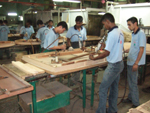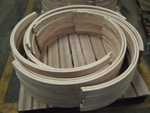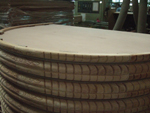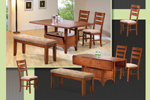Furnishing quality
10 February 2009
The Green River Wood & Lumber Manufacturing group has annual sales of US$450m emanating from one furniture factory in Taiwan, five in China, one in Malaysia and seven in Vietnam. It also started production at its only panel factory (so far) in Hat Yai, Thailand in September 2008, where it makes particleboard (see p36).
Green River started in business in
furniture making in Taiwan and moved into Malaysia in 1988 as its first
overseas venture.
The Malaysian furniture operation is located in Port Klang, in the state of Selangor on the west coast of peninsular Malaysia and not far from the capital city Kuala Lumpur.
Each furniture factory in the group operates as an independent unit and the Malaysian operation is the only one to concentrate solely on dining furniture. Other factories variously produce bedroom furniture and kitchen cabinets and hardwood flooring.
The furniture produced at Port Klang is not of the pile-it-high-and-sell-it-cheap low end variety but solid dining tables with quality veneered surfaces, and solid wood chairs, aimed principally at the mid to upper end of the North American furniture market, where 75-80% of production goes. The balance mainly goes to Russia.
Although Green River has just started up its own particleboard factory, the table tops in Port Klang are in fact made principally of MDF, employing two thicknesses of 18mm laminated together to make a 36mm nominal top. Around 10% or less of the panel product used in the factory is particleboard – it is more suited to the cabinet work carried out in the kitchen and bedroom furniture factories of the group, or sold in its local market to outside customers.
The panels in the base storage units of some tables, where there are wine racks, cupboards and/or drawers, are also MDF.
“We used to use E2 grade MDF but from mid-January 2009 we switched to 100% E1, P1 due to the CARB (California Air Resources Board) regulations in the US,said Albert Hsueh, who is in charge of R&D marketing for the Port Klang company.
“We are currently thus meeting CARB phase 1 (P1) but in 2011 we will meet P2, which will need at least E0 panels.”
The CARB rules are quite stringent and testing of a piece of furniture for compliance can even mean ‘de-constructing’ that item and testing its individual components – such as the MDF without its factory-applied veneer layer. CARB’s arrival has been well publicised, but Mr Hsueh has still found that customers are not necessarily aware of the implications.
“Under CARB, we are considered to be a ‘fabricator’. Often, our customers in the US are unaware of the effect of the CARB regulations and we have to supply the information to them. In fact, one or two customers didn’t even realise the regulations existed – and one of them was actually in California!”
As it would be hard to differentiate raw boards which did comply with CARB P1 from those which didn’t, and separate stocks would have to be kept, Green River has moved totally to P1-compliant MDF.
“We are one of the first factories in Malaysia to be fully compliant,said Mr Hsueh. “It was a big headache for us – especially as we had to dig out a lot of the required information on our own – but we are there now. The P2 level seems unreasonable at this time but we will have to comply of course.”
Some components of the furniture that is assembled and finished at Port Klang are made on the premises and some are shipped in from Taiwan and Vietnam, or from local sub-suppliers. Turned table pedestals for instance are made in a Green River-owned facility close to the main factory, while chair backs in the white (ie unstained/
unfinished) are bought in. Seat frames and stretchers are made on site.
The chairs are made of solid rubberwood and the seats are upholstered inhouse. The chairs and the veneered table tops and legs are stained and finished to match each other in cherry, oak or birch finish.
There are five ranges of dining furniture, known as Contemporary, Cottage, Transitional, Classic and Mission.
Handmade in Malaysia
Much of the work at Port Klang is done by hand and there are 800 workers of many Asian nationalities employed there.
The chair backs, frames and stretchers are dipped in tanks of stain and then hand wiped and hung on a moving overhead
conveyor to dry.
Until the end of 2008, seat bases were plywood but Green River was unable to find a CARB-compliant plywood manufacturer and has thus had to change over to solid wood panels. However,
plywood table aprons (deep edges) for circular tables are CARB-exempt because they are bentwood.
In the raw materials warehouse are packs of particleboard from Metro of Thailand, and of MDF from DongWha of Malaysia, all marked up as P1 compliant. We have to keep those labels for two years as part of our CARB compliance,said Mr Hsueh.
The factory consumes around 900-1,000m3/month of MDF panels and 200m3 of particleboard.
Veneer is hand-laid onto the MDF table tops, which are then hand fed to a press, after which they are passed through Sheng Shing wide-belt sanders. They are then quality checked before being stained and spray finished.
Where circular table solid wood edges are to be embossed with a pattern, this is pressed into the wood in a special curved press with appropriate dies.
At the end of the line, and following visual inspection at each stage of the production process, the table and chair kits of parts are packed into cardboard boxes, with moulded polystyrene protection, for shipment to any one of 160 customers worldwide. Everything is made to order – the factory holds no stock of finished furniture. It does, however, have a two-storey showroom on site to show off its different sets of dining furniture to best effect.
Green River as a group has no intention of standing still with the production facilities that it has. “We are looking for investment opportunities in countries that are new for us and are always keeping our eyes open but in the current economic climate we are taking our time. We will wait and see what happens in 2009,concluded Mr Hsueh.



